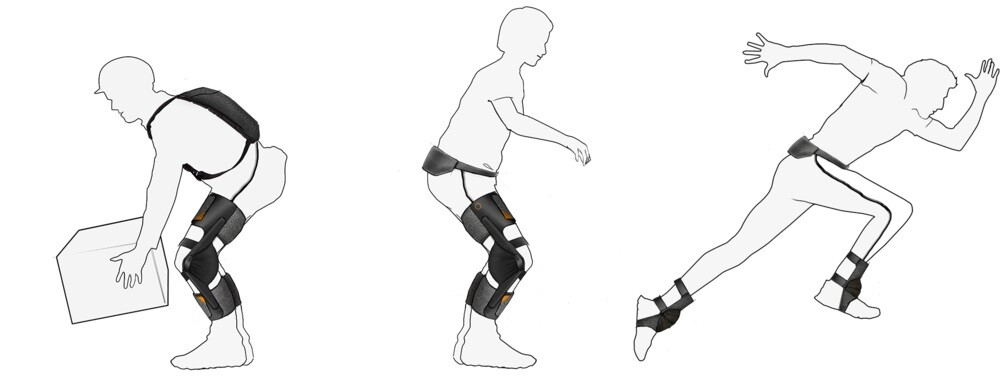If the vision of San Francisco startup Roam Robotics and its co-founder Tim Swift are fully realized, we could be buying commercial lightweight exoskeletons to run faster, hike further and lift more with less effort in the coming years. While still in early stages, the company has developed a lightweight and inexpensive design to give a boost to the limitations of the human body that might finally push such bionics beyond science fiction and on to store shelves.
We spoke to Swift at length about his current venture, which is centered around a design made predominantly out of plastic and high-strength fabric without sacrificing the kind of power provided by far bulkier electromechanical exoskeletons.
"People don't want things that are really heavy on their body. Weight is horrible to wear," Swift told us. "You really quickly notice it as far as your effectiveness and efficiency."
Swift says part of the idea behind the lightweight design is to address a critical problem with almost all exoskeletons that have ever been developed over the decades.
"They've (the exoskeleton community) been trying to build big, heavy bulking strong things and then switched over to building light things but they never changed their toolset."
Swift knows a thing or two about those conventional exoskeletons. He was on the team that developed Ekso, a robotic exoskeleton designed to allow paraplegics and others to walk.

The Roam solution he developed after leaving Ekso Bionics involves creating structured air cavities using fabric that are attached to a brace that fits over the user's joints to apply external torque in just the right way. To push air into the cavities in order to direct the desired force in the right way, Swift says they pulled a completely different toolset "off the trash heap of robotics."
Specifically, he's talking about pneumatics. Valves within the exoskeleton push air from an attached compressor into the structured cavities, generating the extra force needed to add some power to a movement. Swift claims the result looks to be about an order of magnitude more than what electromechanical systems can do for specific movements at the joint.
"For the first time, the physics are in the favor of an exoskeleton," he says, explaining that when comparing the burden of mass of the exoskeleton and the benefit of power it provides, only one electromechanical system has ever actually generated an overall metabolic benefit, and it was only capable of doing so at walking speed.
"No conventional exoskeleton is physically capable of delivering the dream of running faster ... We do it every day."

Swift says that, unlike conventional exoskeletons that tend to be unattainably expensive for most people, Roam is actually looking at consumer applications for its technology.
"The goal is to make devices regular people can get access to. It could be you go to Foot Locker and buy a shoe that makes you run 25 percent faster, or you go to REI to buy a device that helps you hike farther."
When pressed he says that the target cost for a system a consumer could actually buy at retail would be a few thousand dollars. That's compared to electromechanical exoskeletons that run in the tens of thousands of dollars on the low end to, well ... a lot more.
He points out that using inexpensive manufacturing techniques like sewing and injection molding rather than the high tech processes behind most other robotics could help make this possible.

Ideally, a Roam system would also be remarkably lightweight. The entire package consisting of the braces worn at the joint connected to a small battery, electronics board and lightweight compressor in a small lumbar backpack could weigh as little as five pounds or even less.
"That's a target we're looking at," Swift says.
But he's also cautious to stress that it's still early days for Roam Robotics, which was just recently spun out of Otherlab, but has yet to raise any investment of its own. Still, Swift says the team is venturing down the road towards going to market by putting prototypes through paces and seeing what potential products and applications could emerge.
Swift explained the basics of the technology at Otherlab in the video below:
Demonstrating those potential products is probably still a few years away and Swift says he doesn't want to over-hype the potential before all the company's ducks are fully in a row. But it's clear that he's excited about that potential to a degree that makes it a little hard to totally repress.
"We're doing things in our lab right now where we're orders of magnitude beyond what any exoskeleton can even flirt with."
He says that for now, the raw energy input and output numbers in the world of exoskeletons are plainly in Roam's favor, at least until somebody makes super-cooled or super conductive motors that could power a next generation exoskeleton.
Sounds like exactly what investors and potential customers would want to hear. Swift said he hopes to have more clarity on the company's roadmap to market later this year. We'll be sure to check back then.
Company page: Roam Robotics







![The Ti EDC [everyday carry] Wrench is currently on Kickstarter](https://assets.newatlas.com/dims4/default/0ba225b/2147483647/strip/true/crop/4240x2827+0+3/resize/720x480!/quality/90/?url=http%3A%2F%2Fnewatlas-brightspot.s3.amazonaws.com%2F59%2Fb2%2F6a6fdd0348a8bfdad88bbcefec53%2Fdsc03572.jpeg)